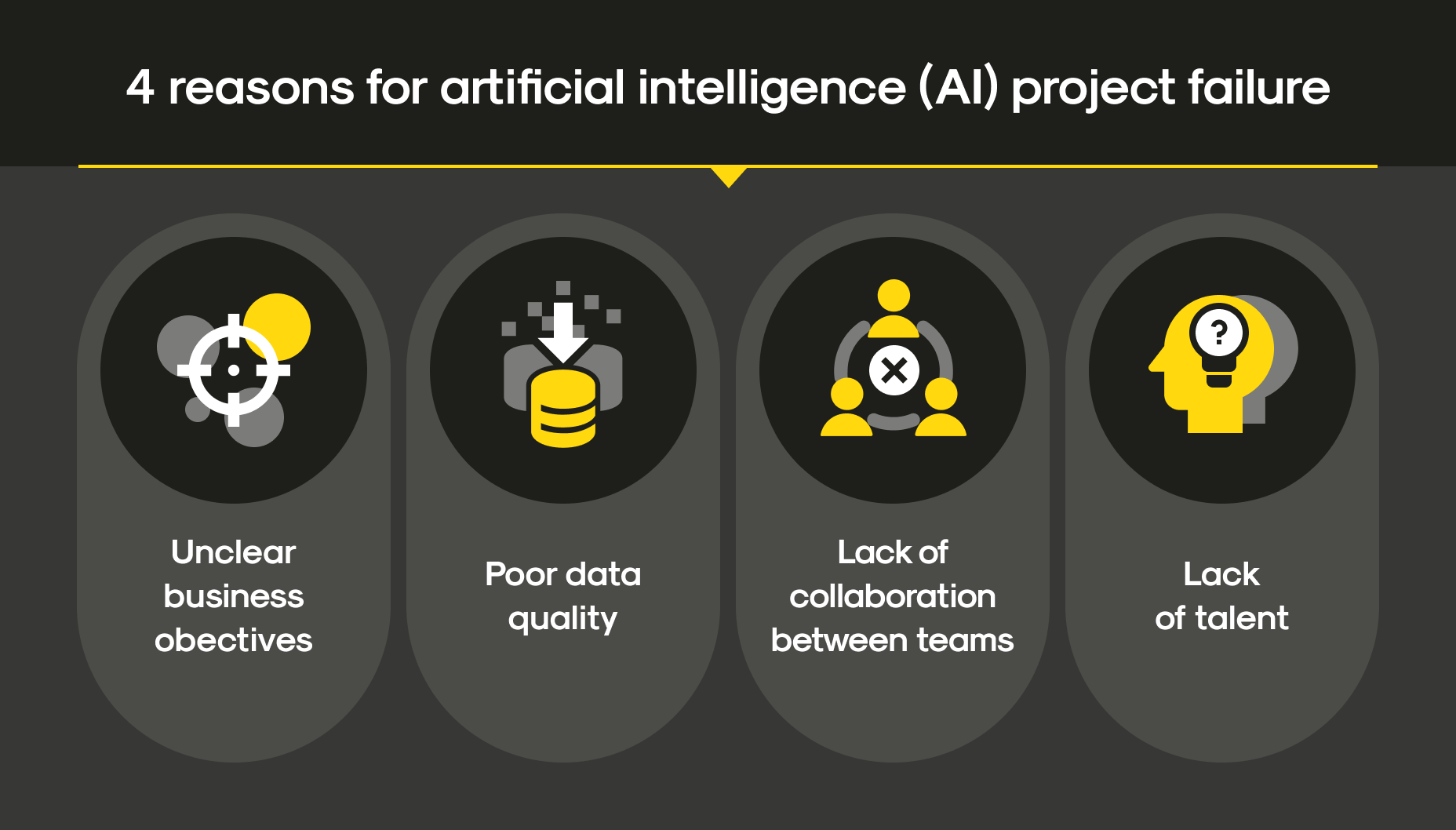Over the last couple of years, artificial intelligence (AI) has been hyped as the ultimate game-changer, promising everything from instant insights to fully autonomous operations. But reality is, AI often over-promises and under-delivers. Despite the setbacks, AI isn’t a lost cause. Many of its “failures” stem from misaligned expectations, poor integration, or lack of human oversight, but not the technology itself.
When implemented thoughtfully, AI can still streamline workflows, uncover insights, and enhance decision-making. The key is understanding where it truly adds value, which tasks benefit most from automation, and how to manage its limitations responsibly. Here’s a look at the most common AI letdowns, and why businesses need to temper expectations while still embracing its potential.
In this article, you’ll learn:
- Why AI so often over-promises and under-delivers, and what that means for businesses today
- The most common “AI letdowns,” from hallucinations to ROI ambiguity, and the lessons behind them
- Why governance, oversight, and careful integration are essential to avoid ethical and reputational risks
- How companies can separate hype from reality and adopt AI with measurable, sustainable results
- Practical steps for embedding AI into workflows, from pilot projects to KPI-driven scaling
- Why AI should be treated as a collaborator rather than a replacement, and how to manage expectations responsibly
- The role of long-term strategy, continuous improvement, and human oversight in unlocking AI’s real value
- How Mitrix helps organizations move past the hype with tailored AI/ML solutions, generative AI agents, and seamless integrations.
Challenges in working with AI
AI is often marketed as a silver bullet, capable of transforming business operations overnight. The reality, however, is far more nuanced. While AI holds tremendous potential, its deployment comes with challenges that every organization must navigate carefully. Below, we break down the most common areas where AI promises more than it delivers, and what lessons businesses can take from each.
The hallucination problem: AI makes stuff up
AI can confidently generate completely false information. From fabricated reports to nonexistent citations, relying blindly on AI can be risky. Always verify outputs and treat AI as a helper, not an authority.
Promise. AI provides accurate answers instantly.
Reality. As of today, generative AI often fabricates information with confidence. Reports, code, and even citations can be completely wrong. For high-stakes decision-making, these “hallucinations” can be disastrous.
Example. An AI legal assistant suggesting non-existent case law or a chatbot giving incorrect medical advice.
Lesson. Always verify AI output: treat it as a helper, not an oracle.
AI as a magic productivity tool
In fact, AI can speed up certain tasks, but gains are uneven. Some teams see real efficiency boosts, others only marginal improvements. Human oversight and process adaptation remain essential.
Promise. AI will cut your workload in half overnight.
Reality. Gains are uneven and context-dependent. While AI copilots in software development can reduce repetitive coding, other functions see marginal improvements. Deployment, training, and integration take time and resources.
Example. Marketing teams generate hundreds of drafts with AI, but human review is still required to avoid off-brand or incorrect messaging.
Lesson. Factor in human oversight and process adaptation. But remember: AI accelerates work, it doesn’t replace expertise.
Overhyped autonomy
All in all, AI is not a full replacement for humans. Most systems need supervision and guidance, especially in complex environments. Think of AI as a collaborator, not a replacement.
Promise. AI will replace humans completely (oh, okay).
Reality. Most AI systems require ongoing supervision. Autonomous agents exist, but they’re far from fully reliable in complex, dynamic environments.
Example. AI-driven supply chain optimization may flag issues, but often fails to account for unforeseen real-world disruptions.
Lesson. Treat AI as a collaborator, not a replacement. Period.
Ethical and reputational risks
Well, the truth hurts: AI can unintentionally introduce bias, privacy issues, or ethical pitfalls. Around a quarter of companies report reputational risks, making governance and auditing crucial before scaling.
Promise. AI can be safely deployed without oversight.
Reality. Around 25% of companies report reputational risks from AI, and 15% cite ethical concerns. Bias, privacy violations, and regulatory missteps remain major pain points.
Example. Facial recognition misidentifying minorities or biased recruitment algorithms.
Lesson. Implement governance, auditing, and ethical frameworks before deploying AI at scale.
Integration nightmares
Plugging AI into legacy systems often turns out more complicated than expected. Poor integration can cause more headaches than solutions, so involve IT early and plan for ongoing maintenance.
Promise. AI plugs seamlessly into existing systems.
Reality. Embedding AI into legacy workflows is often harder than expected. Teams underestimate complexity, and pilots can fail.
Example. An AI chatbot that can’t access your CRM or ERP properly becomes more of a headache than a solution.
Lesson. Plan integration carefully, involve IT early, and anticipate maintenance overhead.
ROI uncertainty
AI doesn’t automatically deliver big savings or revenue. Some tools reduce errors, but financial benefits are often gradual. Track KPIs carefully and manage expectations.
Promise. AI will drive measurable cost savings and revenue growth immediately.
Reality. Some applications show clear savings, but monetizing AI remains tricky. Businesses often overestimate near-term ROI while underestimating long-term operational costs.
Example. A predictive analytics tool may reduce errors, but the financial benefit is subtle and gradual.
Lesson. Track KPIs carefully and avoid chasing flashy AI for the sake of hype.
Vendor lock-in and data risks
Third-party AI solutions can expose sensitive data and create dependencies. Prioritize transparency, compliance, and options for on-premise deployment to reduce hidden risks.
Promise. AI solutions are plug-and-play and universally safe.
Reality. Vendor dependencies, opaque models, and data sovereignty issues can create hidden risks. Exposing sensitive data to a third-party AI can have legal and security consequences.
Lesson. Choose vendors with transparency, compliance guarantees, and the option for on-premise deployment where possible.
AI isn’t something to avoid; it’s something to understand. By recognizing its limitations, planning for oversight, and aligning expectations with reality, businesses can harness AI effectively without falling victim to hype. Treat AI as a strategic partner, integrate it thoughtfully, and measure its impact consistently, and its real value will emerge.
Key takeaways
AI delivers real value, but it also comes with limitations and risks. Understanding its limitations, potential risks, and the need for careful implementation is crucial for turning promise into performance.
- Expect hallucinations, human oversight, and uneven results.
- Prioritize governance, integration planning, and ethical deployment.
- Measure ROI carefully and consider AI as part of a long-term strategy, not a short-term gimmick.
By acknowledging these realities, companies can harness AI effectively. What does it mean? It means balancing innovation with oversight, integrating it thoughtfully into workflows, and building long-term value rather than chasing short-term hype.
Practical steps for realistic AI adoption
Adopting AI successfully is less about chasing the latest models and more about embedding it thoughtfully into your workflows. Start by identifying the areas where AI can deliver measurable impact. Look for repetitive tasks, data-heavy processes, or decision-making bottlenecks. These are the places where AI can enhance efficiency and accuracy without introducing excessive risk. By narrowing the focus, companies avoid the trap of deploying AI as a flashy experiment rather than a tool with tangible benefits.
Next, build a framework for governance and oversight. Establish clear policies around data handling, model evaluation, and ethical use. Assign accountability for monitoring outputs, verifying results, and addressing anomalies. Hallucinations, bias, and misinterpretation aren’t just technical issues: they can affect brand reputation, legal compliance, and customer trust. A structured oversight system ensures that AI remains a helper, not a liability.

4 reasons for artificial intelligence (AI) project failure
Integration planning is equally crucial. Many organizations underestimate the effort required to embed AI into legacy systems, workflows, and cross-department processes. Early collaboration with IT, operations, and business teams can prevent costly misalignments. Pilot projects should focus on achievable goals, generating structured insights that inform broader deployment. Avoid the temptation to implement multiple AI solutions simultaneously; scaling too quickly often leads to maintenance headaches and inconsistent results.
Finally, measure outcomes rigorously. Establish KPIs tied to efficiency, accuracy, or business growth, and track them continuously. Don’t rely solely on anecdotal success or “wow” factor; the financial and operational impact should guide future AI initiatives. Treat AI as a long-term investment: improvements often accumulate gradually, and sustained adoption is more valuable than short-lived spikes in performance.
How Mitrix helps
At Mitrix, we deliver AI/ML and generative AI development services that help companies:
- Design intelligent bots that understand supply chain workflows
- Integrate chatbots with tracking systems, CRMs, ERPs, and TMSs
- Build multilingual, multi-channel support agents (WhatsApp, web, SMS)
- Monitor performance and apply machine learning for ongoing improvements
We help companies turn AI hype into practical outcomes:
- Build AI agents tailored to your workflows
- Integrate systems seamlessly across CRM, ERP, and support platforms
- Monitor performance and continuously improve AI outputs
- Ensure compliance, ethical standards, and reliable operation
AI won’t solve every problem overnight, but with the right approach, it can become a strategic enabler rather than a headline disappointment.
Summing up
While AI hype may be cooling, the technology itself is far from over. Its potential to enhance productivity, uncover insights, and streamline operations is real, but only when approached with discipline, oversight, and realistic expectations. Overpromises about instant results, full autonomy, or effortless integration can lead to setbacks if not carefully managed.
The key to benefiting from AI lies in balance: treat it as a powerful collaborator, not a replacement for expertise. Focus on governance, integration, and measurable outcomes, while remaining aware of risks such as hallucinations, ethical concerns, and ROI uncertainty. Companies that adopt this thoughtful approach will be the ones turning AI’s promise into lasting value.


